Das Keyboard Unveils Its First Gaming Peripherals
by Anton Shilov on January 28, 2016 11:30 AM EST- Posted in
- Keyboard
- Mouse
- Das Keyboard
- Division Zero
- X40
- M50
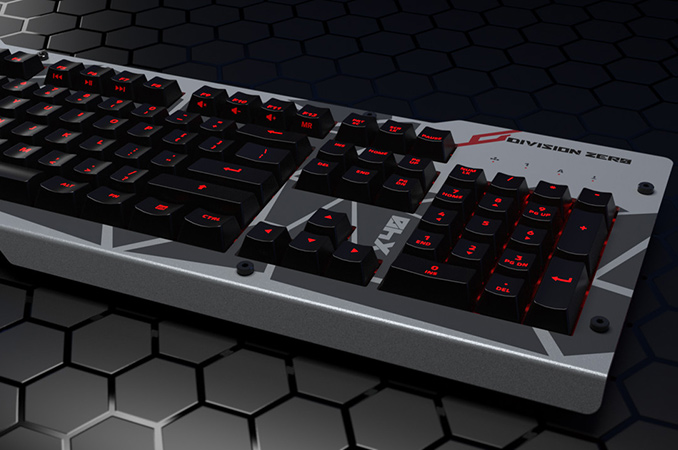
The Das Keyboard trademark is best known for mechanical keyboards designed for the combination enthusiast and professional. For many years Metadot, the owner of the brand, has been going through the process of improving its keyboard design in a bid to bolster comfort for those who type a lot. However, the rising popularity of PC gaming and growing popularity of high-end gaming peripherals means that companies are developing solutions for this market segment. This week Metadot introduced Division Zero by Das Keyboard, the family of products designed for gamers.
From Pro to Gaming
The history of Das Keyboard began in 2005 when Daniel Guermeur, the owner of Metadot, decided to create a keyboard with blank keycaps in order to speed up his typing and remove the imbalance of printed or embossed keys. The first version of Das Keyboard resembled IBM model M keyboard and did not feature mechanical switches. Nonetheless, it became relatively popular among enthusiasts. In 2006, the second iteration of Das Keyboard emerged: it featured similar design with blank keycaps, but mechanical switches with tactile feedback. At the time, mechanical keyboards were rare, so the second-gen Das Keyboard turned out to be more popular than the first. The third version of the Das Keyboard was launched in 2008 and it was vastly different from its predecessors. The new keyboard sported a minimalistic X40 design, a built-in USB hub, blank or marked keycaps as well as Cherry MX switches (originally introduced in 1984) with improved tactile feedback. The third iteration of Das Keyboard appealed to gadget gurus, gizmo elitists, touch-typers as well as average professionals searching for quality hardware (i.e., the higher-end of the mass market). The keyboard is still commercially available, which is a testament of its commercial success.
The Das Keyboard III gave the brand a voice among broader audiences, but also popularized Cherry MX switches among gamers and professionals by showing advantages of such switches over then popular dome and buckling spring switches. One could argue that the Das Keyboard III largely rejuvenated mechanical keyboards on the mass market. Since 2010, many makers of accessories for gamers have released their keyboards with Cherry MX switches. Moreover, both Razer and Logitech have even developed their own mechanical switches for keyboards. However, even in its fourth generation released in early 2014, the Das Keyboard itself remained an item for professionals. With the introduction of Division Zero by Das Keyboard, Metadot enters a new territory.
The initial product lineup of Division Zero consists of the X40 keyboard, the M50 mouse, a gaming mouse bungee (cord management), mousepads, top panels for keyboards as well as a bag. The inclusion of a mouse bungee as well as mousepads into the family implies that the lineup is designed for users who want not only advanced functionality, but 'stylish design' too.
The Division Zero X40 Keyboard
The Division Zero X40 keyboard uses Metadot’s own Alpha-Zulu switches developed, according to the company, specifically for gaming keyboards. The AZ switches have different specifications than the Cherry MX as well as the Razer Green: they have higher actuation point (1.7 mm) and slightly longer advertised lifespan (60 million switches compared to the 50m of Cherry MX linear ones), which, makes them slightly faster and more durable compared to rivals on paper. The differences may seem noticeable (23% shorter actuation distance in theory means 23% higher typing/striking speed), but the real-world benefits of the Alpha-Zulu switches compared to competing switches are yet to be found (which is not an easy thing to do given how fast gamers press keys).
| Comparison of Mechanical Keyboard Switches | ||||||
| AZ Linear | AZ Tactile | Razer Green | Cherry MX | |||
| Actuation Point | 1.7 mm | 1.7 mm | 1.9 mm ± 0.4 mm | 2 mm/2.2 mm ± 0.6 mm | ||
| Actuation vs Reset Point | no data | no data | 0.4 mm | no data | ||
| Total Travel | 4 mm | 4 mm | 4 mm | 4 mm | ||
| Actuation Force | 45 g | 45 g | 50 g | 45-55 g | ||
| Actuation Feel | linear | soft tactile | soft tactile | linear/tactile | ||
| Switch Lifecycle | 60 million | 60 million | 60 million | 50 million | ||
| Switch Color | olive | mustard | green | red/brown/ black/blue |
||
Since there are two different types of Alpha-Zulu switches, and gamers will be able to choose their keyboards based on their preferences.
Just like competing keyboards for gamers, the Division Zero X40 is also equipped with adjustable red LED backlighting, five programmable macro gaming keys, a special 2 meter long braided fiber USB cable combined with audio and mic cables, a USB port (with pass through support) as well as audio-out/mic-in jacks. The keyboard also supports full n-key rollover, features media controls via Fn keys, as well as interchangeable aluminum top panels.
The X40 keyboards are available for $149, a custom cover costs another $39.
The Division Zero M50 Mouse
Metadot is not known for mice, but if you want to compete for gamers, you have to offer a complete product stack, not just one keyboard. Specifications of the M50 are comparable to those of other mainstream gaming mice and the company does not reveal whether the part utilizes any specially-developed hardware.
The Division Zero M50 is an ambidextrous mouse with an adjustable 6400 dpi 4G laser sensor, a metal tilt wheel, 1000 Hz polling rate, nine programmable buttons and red LED lighting. The pointing device has its own microcontroller and memory that can store presets. The M50 Pro can handle up to 300 clicks per minute and has a 20-million primary buttons click life cycle. The mouse comes with a 2.1-meter long cable, which can be managed with Division Zero’s bungee cable management.
| Comparison of Mainstream Gaming Mice | ||||||
| Division Zero M50 | Razer Taipan | Corsair M65 | ROCCAT Kova | |||
| Sensitivity with Overdrive | 6400 dpi | 8200 dpi | 8200 dpi | 7000 dpi | ||
| Polling rate | 1000 Hz | 1000 Hz | 120 - 1000 Hz | 1000 Hz | ||
| Acceleration | unknown | 50 g | unknown | 20 g | ||
| Programmable Buttons | 9 | 9 | 8 | 12 | ||
| Number of Profiles | 6 | unknown | unknown | unknown | ||
| Dimensions (L*W*H) | 129.8*70*34.8mm | 124*63*36mm | 118*72*39mm | 131*66*38mm | ||
| Weight | 132 grams | 95 grams | 135 ± 20.5 grams | 99 g | ||
| Adjustable Weight | no | no | yes | no | ||
| Click Lifecycle | 20 million | unknown | unknown | unknown | ||
| Cable Length | 2.1 m | 2.1 m | 1.8 m | 1.8 m | ||
| LED Lighting | three red LEDs | two green LEDs | three RGB LEDs | two RGB LEDs | ||
| Price | $79 | $79.99 | $74.99 | €69 | ||
The M50 is made of plastic with a hydrophobic coating and a fingerprint resistant coating of primary buttons and a metal bottom. The mouse has low-friction metal Teflon feet, similar to competing products from other manufacturers. The mouse weighs 0.38 lbs/172 grams. The weight of the mouse cannot be adjusted.
The design of the M50 resembles that of Razer’s Taipan, but since Metadot’s product has dissimilar dimensions and weight as well as a different sensor, the M50 does not seem to be a rebadged mouse developed and made by another manufacturer, but a product designed in-house.
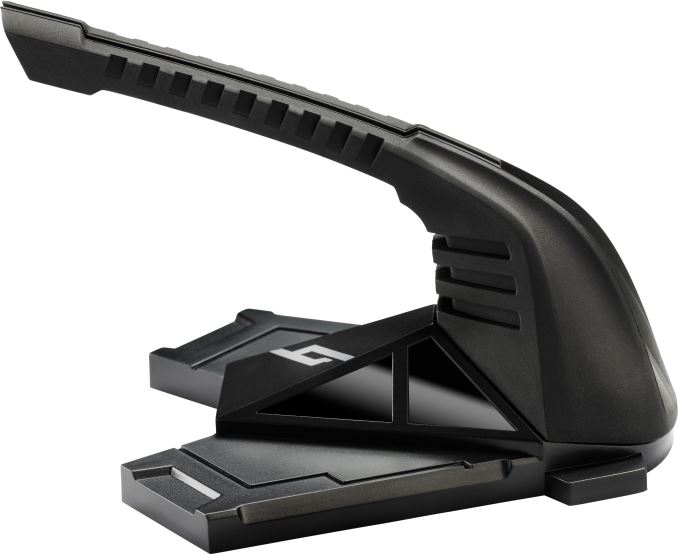
The bungee for cable management
The Division Zero M50 costs $79, the bungee is available for $19 and mouse pads are priced at $19 or $29.
Only The Beginning
The market of gaming peripherals is highly competitive, making it very diverse in order for individual firms to find a niche. Companies like Razer and Logitech offer a lot of different products to meet requirements of different users as a result. Metadot recognizes this and has been offering various versions of Das Keyboard with different types of switches and with different designs for some time now. The Division Zero product lineup consists of essentially three products: one keyboard with two types of switches, and a mouse. It will be interesting to see whether the Division Zero family will expand. It remains to be seen whether the Division Zero by Das Keyboard family will actually make Metadot a viable competitor to Corsair, Razer, Logitech and other on the market of gaming peripherals. Nonetheless, I find it nice to see a well-respected producer of professional keyboards entering the market of gaming devices.
The new models will filter through distribution to etailers such as Amazon over the coming weeks, or can be found on the daskeyboard.com website directly.


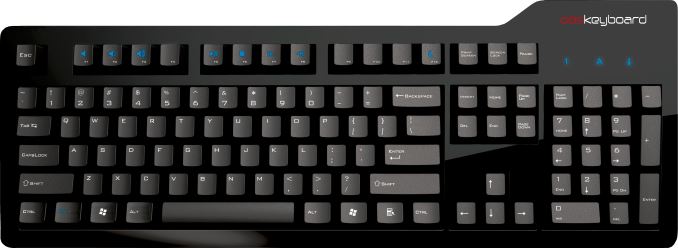
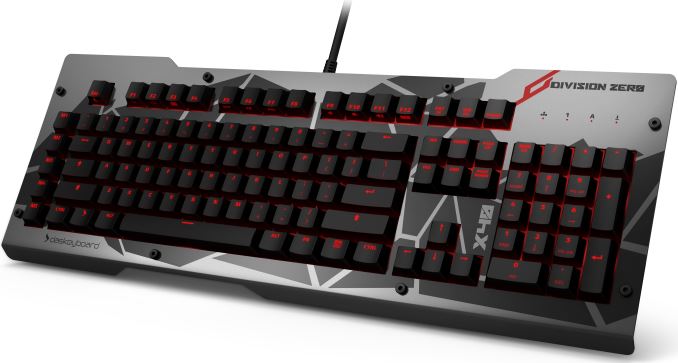
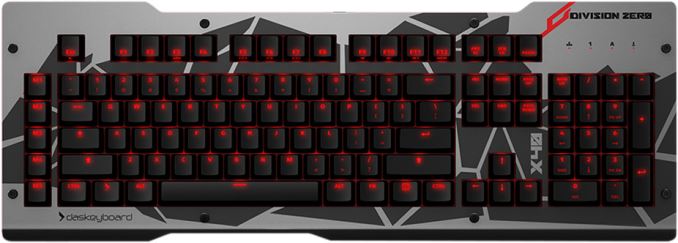






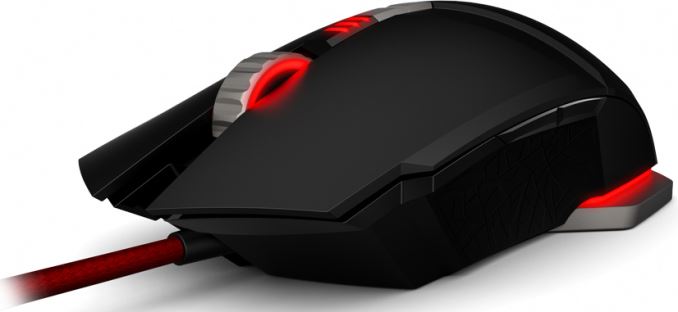
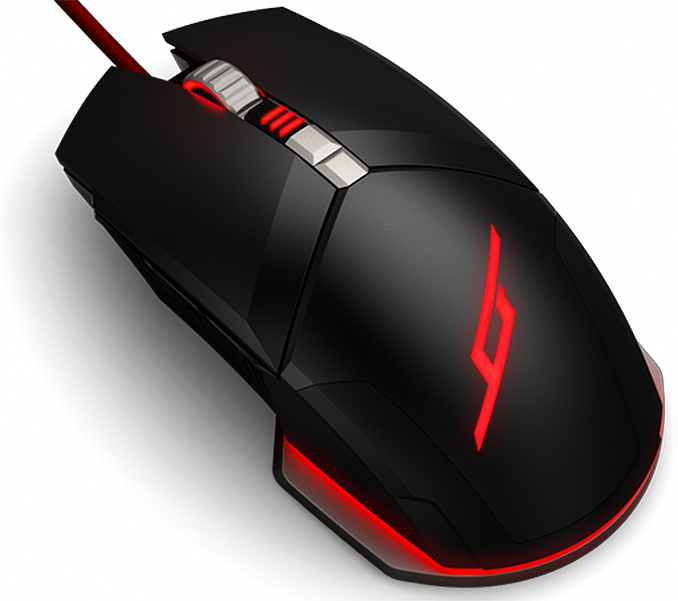













23 Comments
View All Comments
LauRoman - Thursday, January 28, 2016 - link
I would like, one day, to see a mechanical keyboard the size of the Logitech k360.DanNeely - Thursday, January 28, 2016 - link
Would this work for you? It was plugged in the Cherry MX keyboard comments; but I've never used one.http://www.amazon.com/CM-Storm-QuickFire-TK-Mechan...
WithoutWeakness - Thursday, January 28, 2016 - link
The CoolerMaster QuickFire TK has a very similar layout to the Logitech K360 with a full numpad in a "tenkeyless" form factor. The QFTK actually has a smaller footprint than the K360 but they're not the exact same layout. The QFTK doesn't have dedicated arrow keys or media keys like the Logitech board; instead it has them as part of a function layer using the Fn key (the keys are still labeled for cease of use). The QFTK is programmable, however, and also comes in a few varieties of key switch and backlighting options.Leonick - Friday, January 29, 2016 - link
Love that keyboard. Such a fantastic layout. Why doesn't more keyboards use something like it? It's compact compared to a full size keyboard and only a tiny bit wider than a ten-key less yet it has both dedicated arrow keys and numpad.Does anyone really care for the keys (whatever they're called as a group) that traditionally go above the arrow keys or rather their specific layout? People buy ten-key less to get a more compact keyboards, but I for one would much rather have the numpad than that group of keys. (I'm aware of the CM Quickfire keyboards.)
DanNeely - Friday, January 29, 2016 - link
In the last 15 years I've probably used *each* key in the Insert-PgDn cluster more times than *every* key in the numpad combined. Going a few years farther back than that it'd become a wash; due to some DOS games using the numpad as an 8way arrow cluster instead of handing simultaneous keypresses for diagonal.Scattering them into random retardo layouts or fn-combinations is one of the things I loathe the most about most laptop layouts.
Yuriman - Saturday, January 30, 2016 - link
By contrast, I use the numpad very frequently, not only for the numbers, but also for entering special characters. There are plenty of numpad-less keyboards out there for those who don't use them.petteyg359 - Monday, February 1, 2016 - link
Second that. Coding on my laptops becomes painful when the dang home and end keys are placed two inches apart.edzieba - Friday, January 29, 2016 - link
I have one. It's manufactured by Cherry, the backside lists it as "Modell MX 1800 USB". It was a gift, so I do not know where they are available from.http://i.imgur.com/uRxkKUI.jpg
MadAd - Thursday, January 28, 2016 - link
Oh god, same old boxes with same old keys on it, some splashes of plastic branding, mechanical blah blah, billion key rollover blah blah, about the most interesting part of development here is the cable bungee rofl.When o when will peripheral manufacturers actually make something exciting, does nobody spend on R&D any more? Nah lets just make another rectangular box with the same keys as everyone else. Damn thats boring.
xthetenth - Thursday, January 28, 2016 - link
It's weird to say but it's increasingly seeming like mechanical gaming keyboards are getting commodotized and becoming interchangable. I think the best place to differentiate is good macro and other software support.